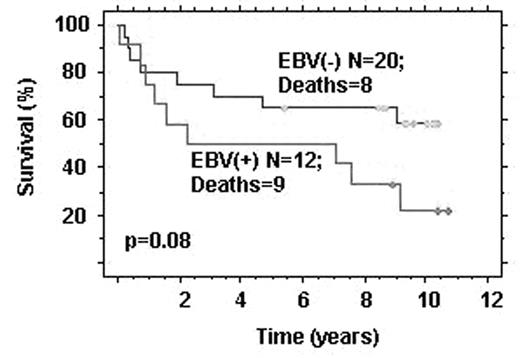Abstract
Purpose: The Epstein-Barr virus (EBV) is implicated in the development of Richter’s transformation in patients with chronic lymphocytic leukemia (CLL)/small lymphocytic lymphoma (SLL). The objective of this study was to assess the incidence and the clinical significance of EBV in patients with CLL/SLL.
Patients and Methods: Patients with CLL/SLL who presented at The University of Texas M. D. Anderson Cancer Center over a two-year period, and had available marrow paraffin blocks were studied for evidence of EBV infection using a highly specific in-situ hybridization assay for detection of EBV encoded RNA (EBERs). Results were analyzed in relation to other presenting characteristics and outcome.
Results: Thirty-two patients were examined. EBERs were detected in 12 of 32 (38%) CLL/SLL marrows versus 0 of 20 normal marrows (p = 0.002). EBERs were observed in sporadic granulocytes alone or in addition to its presence in lymphocytes in nine of the twelve EBV-positive patients. EBERs were detected less frequently in patients with Rai stage 0-1 disease (20%) compared with Rai stage 2–4 (66%; p=0.008); EBER-positive patients tended to have higher lactate dehydrogenase (LDH) levels (p=0.053). The 10-year survival rate was 22% versus 58% for patients with and without discernible EBERs (log-rank, p=0.08).
Conclusions: Evidence of EBV infection was found in 38% of CLL/SLL patients assessed. Despite the small number of patients tested, discernable EBERs were significantly more common in individuals with more advanced Rai stage, and there was a trend toward shorter survival in patients in whom EBV EBERs were discerned. Larger studies are needed to determine the prognostic value and role of EBV infection in patients with CLL/SLL.
Author notes
Corresponding author


